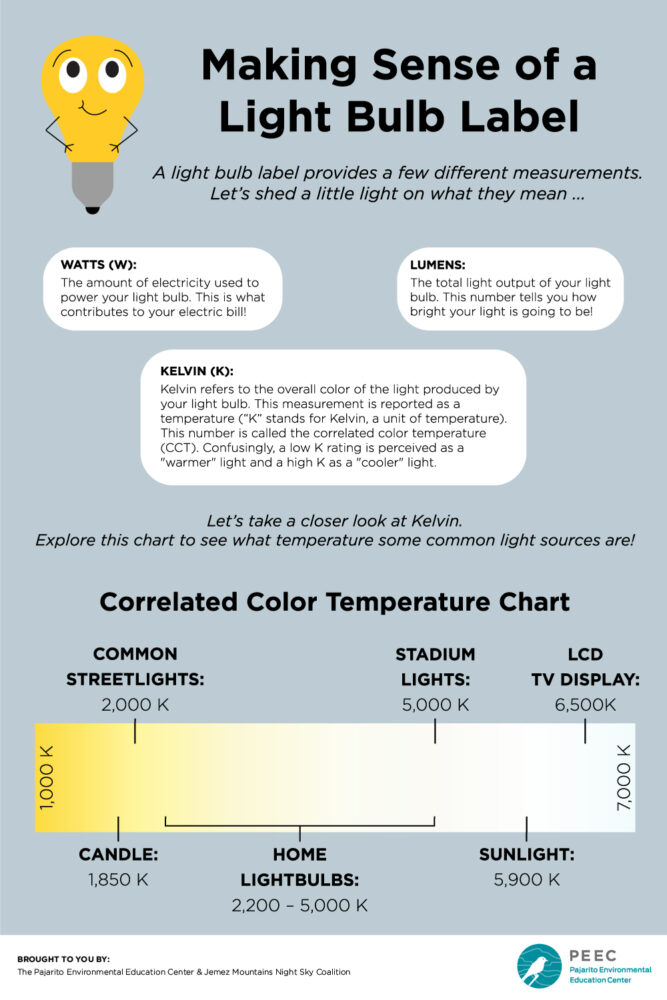By Didier Saumon, Jemez Mountains Night Sky Coalition
Buying a light bulb used to be simple. Up until about 15 years ago, nearly all light bulbs on the consumer market were of the incandescent type (with a coiled filament inside), labeled in watts. When we needed a bright light we chose a 100 watt bulb and for applications requiring less light, we chose 40 or 60 watt bulbs.
It’s no longer quite so simple. Light Emitting Diode (LED) technology is rapidly taking over nearly all applications, and there is a much greater variety to choose from. Bulbs and fixtures are now labeled with watts, lumens, and “K,” complemented with terms such as “soft white,” and “daylight.” What does it all mean? This article in our series on light pollution aims to demystify these technical terms to help navigate the purchase of light bulbs and fixtures.
The number of watts (“W”) refers to the amount of electric power used by the light. This is what contributes to your electric bill. Different types of bulbs vary greatly in efficiency, which is the amount of light produced by a given amount of power.
When we select a light fixture, we first want to know how bright it is. The brightness of a bulb is properly quantified in lumens (total light output), not in watts (electric power consumed). For example, a standard 60W incandescent bulb produces about 800 lumens of light. Currently, an LED bulb of the same brightness of 800 lumens consumes only about 10W — only one-sixth the amount of electricity as the incandescent bulb! This reduction of energy consumption is one of the great advantages of LED technology. Conversion tables between watts and lumens for different types of bulbs are easily found on several websites.
A trickier concept is the number of “K.” This refers to the overall color of the light produced and is reported as a temperature (“K” stands for Kelvin, a unit of temperature). This number is called the correlated color temperature (CCT). Familiar sources of light span a wide range of CCT: LCD displays of television, computer monitors, tablets and phones (all above 6500K), sunlight (5900K), fluorescent tubes (5000K), incandescent light bulbs (2500K), common high pressure sodium streetlights (2000K), and candle flames (1850K). Consumer LED bulbs typically range from 2200 to 5000K. Notice that the whiter/bluer sources of light have a higher color temperature. Confusingly, common language refers to whiter/bluer light as feeling “cool” and yellower light as “warm” but in terms of CCT blue lights are hotter than yellow ones. The chart below illustrates the appearance of lights of various color temperatures.

The color of light was not much of a concern when nearly all consumer lights were either incandescent bulbs (“warm”) or fluorescent tubes (“cool”). Now we can choose the CCT depending on the application. Whiter (4000K – 5000K) light is good for retail spaces and work areas where detailed visual acuity is necessary. For indoor domestic use, such light is generally considered harsh and unpleasant (we generally don’t use fluorescent lights in dining areas) and a CCT of 2700 – 3000K is usually preferred. For outdoor domestic and commercial use, lights with a warmer feel (2700K or less) create a much more pleasant ambiance while lights with 5000K feel especially harsh.
In a nutshell, the number of watts (e.g. 10W) indicates the electric power used by the fixture (how much it costs to run). The brightness is given by the number of lumens (e.g. 500 lumens). The color of the light is described with a temperature, given as the number of degrees Kelvin (e.g. 3000K).
In the next article of this series from the Jemez Mountains Night Sky Coalition, we will see how principles of good outdoor lighting can be put into practice when facing the vast array of lighting fixtures available to consumers.

